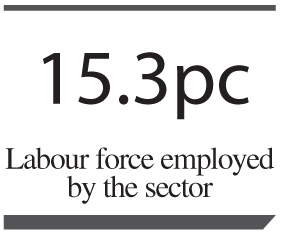
ISLAMABAD: Manufacturing recorded a growth of 5 per cent against 3.9pc of last year which helped overall industrial sector to improve by 6.8pc against 4.8pc last year.
Followed by agriculture, manufacturing is the second largest sector of the economy, accounting for 13.6pc of the Gross Domestic Product (GDP). It comprises textile industry, engineering, agro-based plants, chemicals and small and medium enterprises. It provides employment to 15.3pc of the total labour force.
Large Scale Manufacturing (LSM) dominates overall sector at 10.9pc of the GDP, accounting for 80pc of the sectoral share followed by small scale manufacturing which accounts for 1.8pc of the total GDP.
LSM registered a growth of 4.70pc during July-March of fiscal year 2016 as compared to 2.81pc in the same period last year.
At the same time, a decline in the growth has been recorded in coke and petroleum products at 2.40pc compared to 5.47pc last year whereas textile registered a growth of 0.62pc against 0.97pc last year.
The finance ministry has added that the performance of textile sector having highest weight in Quantum Index of Manufacturing remained subdued on account of lacklustre demand overseas due to global economic slowdown, more specifically in China along with a decline in the domestic cotton production.

The Economic Survey revealed that automobiles recorded highest growth of 23.43pc in the outgoing fiscal year as compared to 17.06pc last year, fertilisers 15.92pc compared to 0.95pc last year, chemicals 10.01pc compared to 6.67pc last year, rubber products 11.68pc compared to 1.88pc last year, leather products 12.18pc compared to 9.11pc last year, pharmaceuticals 7.21pc compared to 6.84pc last year. Petroleum products recorded a growth of 4.32pc over previous year, mainly because of higher production of LPG, lubricating oil, petrol and jet oil.
The non-metallic mineral products recorded a growth of 10.23pc compared to 2.71pc last year, food, beverages and tobacco 3.66pc compared to negative growth of 0.93pc last year.
The ministry of finance has said that the decline in global commodity prices benefited many industries locally, such as food, automobile, cement and chemicals and construction activities, while improved availability of gas supplies facilitated fertiliser and cement sector.
The government said that the LSM also benefited from continued improvement in supply of electricity and gas, coupled with expansion in credit to private sector.
The government has estimated that the LSM will further gain momentum from the development work on projects under China-Pakistan Economic Corridor (CPEC).
Published in Dawn, June 3rd, 2016















































Dear visitor, the comments section is undergoing an overhaul and will return soon.